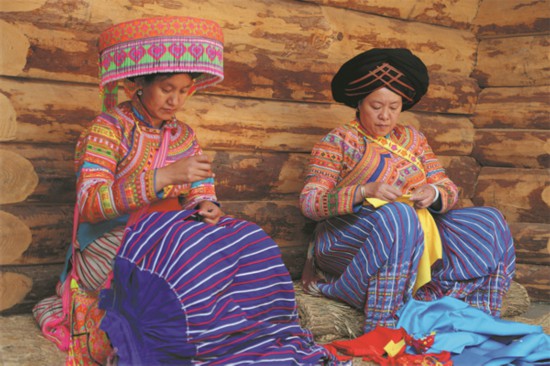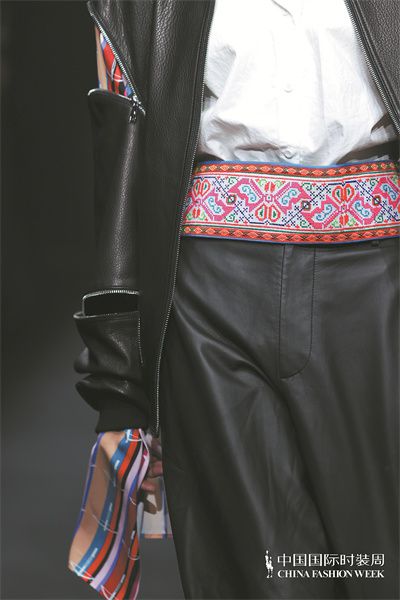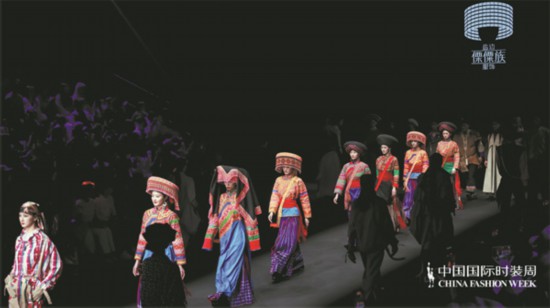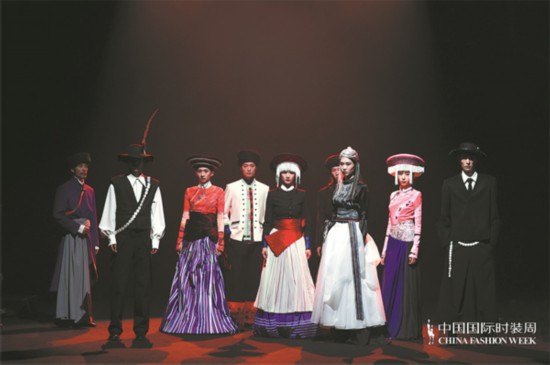Photographer Ren Peng, 40, remembers the occasion as if it was only yesterday. Five years ago he visited the hometown of his friend Gu Yan, a member of the Lisu ethnic group, in Yanbian county, Panzhihua, Sichuan province. Ren was impressed by the labor-consuming traditional techniques of making Lisu costumes, a provincial-level intangible cultural heritage item.
Leaves of fire grass, a special plant that often grows in the mountainous area of southwestern China, are used to make the costumes. "People can get fibers by rubbing the leaves, and then spin to make threads and weave cloth. The whole process has more than 20 procedures and takes eight to 12 months to complete, during which more than 10,000 leaves are required to make just one costume," says Ren.

He Zhengfen (right) and Chen Zhizhen, inheritors of traditional techniques of making Lisu clothes, show their skills at the intangible cultural heritage inheritance center in Yanbian county, Panzhihua, Sichuan province.[Photo provided to China Daily]
The garments made from the grass offer excellent breathability, insect protection and moisture resistance. As a result, they meet the needs of traditional Lisu peoples' lives in the mountains.
He was amazed by the craftsmanship involved in making the clothing. "Nowadays, people don't even need to spend much time producing a car, but making a costume, totally handmade, can take a year. If someone spends a year making a costume for you, how you will feel when wearing it? In the frenzy of modern life, I think it's quite touching," says Ren.
However, the sophisticated skills and exquisitely crafted products are now less recognized. To garner greater public attention for this valuable cultural heritage, Ren and Gu have brought them to a bigger stage — they organized a fashion show themed on Lisu clothing at the China Fashion Week in Beijing recently.

The fashion show features designs with a belt of Lisu style.[Photo provided to China Daily]
The show not only displayed traditional handmade Lisu costumes, but also haute couture and ready-to-wear items inspired by Lisu clothes, says Ren. He adds that cloth, color combinations, Lisu patterns and even the manner of wearing them are now featured in modern designs.
He highlights two pants displayed at the show. Both imitate the traditional trousers of Lisu people. The first one is straight with embroidery at the hem. It replicates the old style, while the embroidery patterns are of modern styles to make them more fashionable.

Models walk the ramp in traditional costumes of Lisu ethnic group at China Fashion Week in Beijing.[Photo provided to China Daily]
Another pair imitates traditional Lisu group's pants with very wide legs just like skirts, but the pant bottoms are tied tight by bands. This, for Lisu people who lived in the mountains, was for protection from insects and convenience.
"I think the styles of trousers comply with modern needs as well, because young people tend to wear loose pants now. With the bands tying the pant bottoms, people may find it interesting. In this way we combine the tradition and contemporary needs," he says.
Moreover, many of the ensembles showcased by the models featured a distinctive hat formed by a long cloth tied around their heads, reflecting the traditional headwear of the Lisu people.
According to Ren, Lisu people often donned the hats during migration or hunting expeditions. The hats, made of ropes, not only gave them warmth but also helped them secure prey on their backs or strap weapons during fights. Additionally, these hats served as decorative elements in their attire. Therefore, they are important accessories in Lisu clothing and are incorporated into modern design.

Designs inspired by Lisu clothing on the runway.[Photo provided to China Daily]
Jiang Zhiyuan, a fashion designer of this show, says his design was deeply influenced by Lisu tradition. He says Lisu people wear a large outer garment and then wrap it around the body with a cloth belt to secure it.
This reminds him of the trench coat. Therefore, he designed new styles of trench coats combining features of Lisu clothing so that people can pair them with their modern outfits.
The major promoter of this activity is Gu, for whom telling the stories of Lisu group has long been a wish of the 40-year-old, also director of a Lisu ethnic group research association in Yanbian. She believes attire is a starting point from which people can get to know her group.
The Lisu ethnic group is believed to be a descendant of ancient Diqiang tribe, which is recorded to have been in present-day Shaanxi, Gansu and Sichuan provinces. Lisu people were constantly migrating and are now mainly in Yunnan and Sichuan provinces.
Without written records, Lisu people depicted stories on their costumes.
"Lisu clothing carries rich historical significance. The flower patterns on our clothing represent flowers from 77 mountains, the belt around our waists represents the rainbow in the sky, the alternating white and red on the pleated skirt symbolizes the 99 rivers and 12 mountain ranges, while the white patterns below signify the path our ancestors took (in their migration)," says Gu.
Influenced by her family members, Gu has valued the promotion of Lisu culture since adolescence. In 2011, when she graduated from IPAG Business School in Paris, she went back to her hometown to be engaged with it.
"When one is in a strange environment, speaking a different language and meeting different people, they tend to go through a period of introspection to see how they were shaped. Lisu culture has shaped me, and I deeply appreciate its value. Therefore, I returned to make it known by more people," says Gu.
Lisu people used to reside in deep mountains with hunting and agriculture as livelihood. They held a reverence for nature. For example, although they gathered fire grass to make clothes, they never cut big trees. When they hunted, they would free pregnant animals and cubs.
Such values, as part of local culture, are precious in Gu's heart and are shown in many of traditional Lisu handicrafts. She disagrees that Lisu costumes with rich colors are outdated, as some people say. "I love black and white art, but the color combinations of Lisu costumes are also attractive, not to mention their cultural significance," says Gu.
In 2019, with support from the local government, she established in Yanbian an inheritance center of the group's intangible cultural heritage to cultivate inheritors of the traditions and integrate their culture with tourist development.
She built five wooden houses, traditional dwellings of the Lisu, to display handicrafts and introduce the group's ceremonies. The center has become a tourist hot pot, attracting more than 50,000 visits every year.
The fashion show is one of her endeavors to make Lisu culture more widely known.
"I want to plant a seed in people's heart. I don't know what will grow out of it, but when more people see our cherished culture, they may develop better ideas of inheriting it," says Gu.
"Our elder generations walked out of mountains where they had resided, and we are standing on their shoulders to face a wider world," she adds.
Pan Yiqiao contributed to this story.
 Editor:Qiu Xiaochen
Editor:Qiu Xiaochen